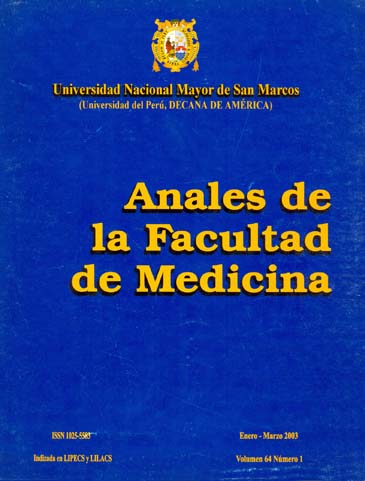Hydatidosis prevalence and risk factors in Peru's Ninacac-pasco district population 2001
DOI:
https://doi.org/10.15381/anales.v64i1.1419Keywords:
Echinococcosis, sampling studies, risk factors, communicable diseases control, rural population, rural zonesAbstract
Objetive: To determine the prevalence and risk factors of hydatidosis in a Peruvian town general population. Design: Transversal analytic study. Material and methods: In 412 residents from the urban area and 261 from the rural area a blood sample was obtained for serology and a survey was applied; hydatidosis cases were those positive to Elisa and Western Blot tests. Results: Hydatidosis prevalence was 9,8% in the rural area and 8,2% in the urban area. Significant risk factors were: age from 11 to 40 year-old, cattle breeder occupation, and residual water discharge within the house (rural area); and a protection factor was dog feeding with cooked viscera. Conclusions: Hydatidosis risk factors in a Peruvian district were economically productive population, direct labor with livestock and dog feeding with viscerae. Implementing a program of local harm control and extending it to the country’s highlands is suggested.Downloads
Published
2003-03-17
Issue
Section
Trabajos originales
License
Copyright (c) 2003 Eloísa Núñez, Doris Calero, Luis Estares, Ana Morales

This work is licensed under a Creative Commons Attribution-NonCommercial-ShareAlike 4.0 International License.
Those authors who have publications with this magazine accept the following terms:
- Authors will retain their copyrights and guarantee the journal the right of first publication of their work, which will be simultaneously subject to Creative Commons Attribution License that allows third parties to share the work as long as its author and its first publication this magazine are indicated.
- Authors may adopt other non-exclusive licensing agreements for the distribution of the version of the published work (eg, deposit it in an institutional electronic file or publish it in a monographic volume) provided that the initial publication in this magazine is indicated.
- Authors are allowed and recommended to disseminate their work over the Internet (eg: in institutional telematic archives or on their website) before and during the submission process, which It can produce interesting exchanges and increase quotes from the published work. (See El efecto del acceso abierto ).
How to Cite
1.
Núñez E, Calero D, Estares L, Morales A. Hydatidosis prevalence and risk factors in Peru’s Ninacac-pasco district population 2001. An Fac med [Internet]. 2003 Mar. 17 [cited 2024 Jul. 3];64(1):34-42. Available from: https://revistasinvestigacion.unmsm.edu.pe/index.php/anales/article/view/1419















